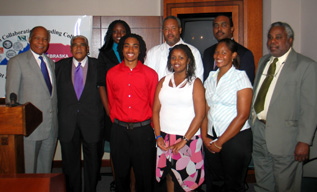 |
From left: Dr. Sullivan, Sen. Lambert, four of the six Virginia-Nebraska Alliance students, Dr. Pamies, Terone Greene and John McClain. |
They plan to accomplish their goal through the Virginia-Nebraska Alliance, a partnership formed this past September between the University of Nebraska Medical Center, Virginia Commonwealth University, five Historically Black Colleges and Universities in Virginia and a leading Virginia community college.
One of the nation’s most distinguished medical educators, Louis W. Sullivan, M.D., spent two days in Omaha this week visiting UNMC, where six Virginia-Nebraska Alliance scholars are spending 12 weeks in UNMC research labs.
“We see these young people as pioneers,” said Dr. Sullivan, president and chairman of the board of the Virginia-Nebraska Alliance. “It’s a unique program. There’s no other program like this in the country.”
The alliance provides a multitude of academic and research opportunities for minority undergraduate students and faculty. The ultimate goal is to increase the diversity of the nation’s health professionals.
“(The alliance) is helping to increase the pipeline of youngsters from minority backgrounds who have the experience and the talent and the capability to be successful health professionals,” said Dr. Sullivan, an adviser to President George W. Bush on health disparities.
“Health care is certainly scientifically based, but it’s delivered in a social setting,” Dr. Sullivan said. “The best outcome occurs when we have well-trained individuals who also understand the culture, speak the language, respect the traditions and generate the trust and communications with their patients.”
Today, African Americans, Native Americans and Hispanic Americans make up more than 25 percent of the U.S. population, but represent only 9 percent of nurses, 6 percent of doctors and 5 percent of dentists.
The alliance is comprised of Virginia’s five HBCUs and one community college: Hampton University, Hampton; Norfolk State University, Norfolk; St. Paul’s College, Lawrenceville; Virginia State University, Petersburg; Virginia Union University, Richmond; and J. Sargeant Reynolds Community College, Richmond.
Virginia State Sen. Benjamin J. Lambert III, vice president of the board, also was in Omaha and stressed the importance of staying in school. “If we don’t open the doors and encourage students to stay in school we will not be a greater America,” Sen. Lambert said. “I’m proud of the Virginia students for making a difference and for being a role model for other students in this nation.”
Tyrone Cherry, a senior education major at Virginia State University, is spending his second summer at UNMC. “It’s really a blessing to be here,” he said. “The experience is unlike anything else that I’ve ever experienced. I’ve done numerous other programs throughout high school and college and none compare to this one. It’s actually research-based. You’re not just someone in the lab observing or listening to someone lecture. You’re doing hands-on research.”
It’s also advantageous, Cherry said, to work with students who are excelling in undergraduate school and are on similar career paths. “That pushes you to do better and you learn from them,” he said.
Supporters of the Virginia-Nebraska Alliance say it will expose and better prepare minority students for health careers. “We believe this will be a model that could be duplicated in other states around the country,” Dr. Sullivan said. “The program is designed to see that our health professions really match our nation’s ideals of which we also strive: that is equal opportunity for all and equal access to health care. We believe this program will help increase the diversity in the health professions and therefore the health of our populations.”
Terone Green, chief executive officer of the Virginia-Nebraska Alliance, accompanied Dr. Sullivan and Sen. Lambert during their two-day visit to Omaha.
“This (selection of participating students) is a collaborative relationship between faculty at all the campuses,” Green said, noting how abstracts are matched to a student’s interests, as part of the application process and review. “It’s very competitive.”
Rubens Pamies, M.D., vice chancellor for academic affairs and dean for graduate studies at UNMC, commended UNMC’s faculty members for welcoming students into their research labs each summer. “It takes a great effort on their part,” he said.
He also applauded the leaders of UNMC and the University of Nebraska “who had the foresight — even though we’re not facing the immediate problems that many of our larger cities with large minority populations are facing — to invest in this type of a program to make a difference in our state, as well as our country. This is a very unique program that has the opportunity to be replicated across the country.”
The students will continue to hone their research skills, network with peers and faculty members and shadow health care professionals at UNMC until early August when they will return to their respective institutions.